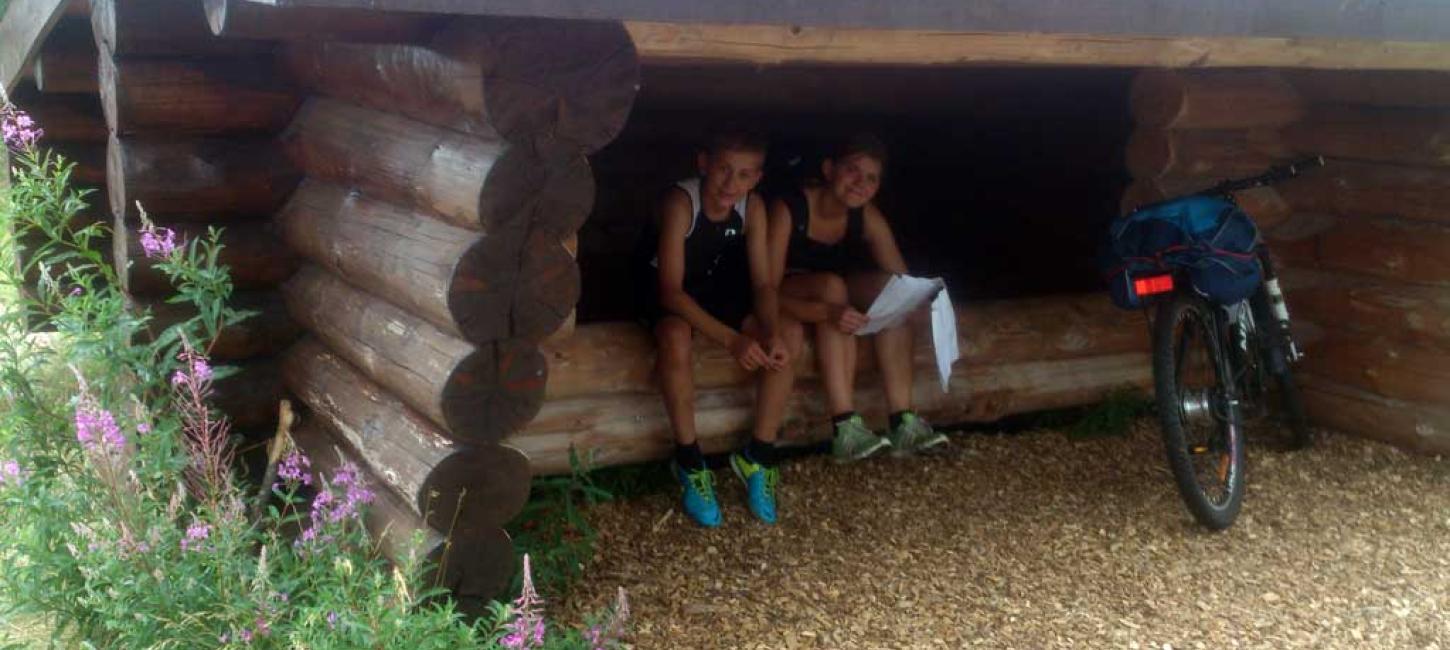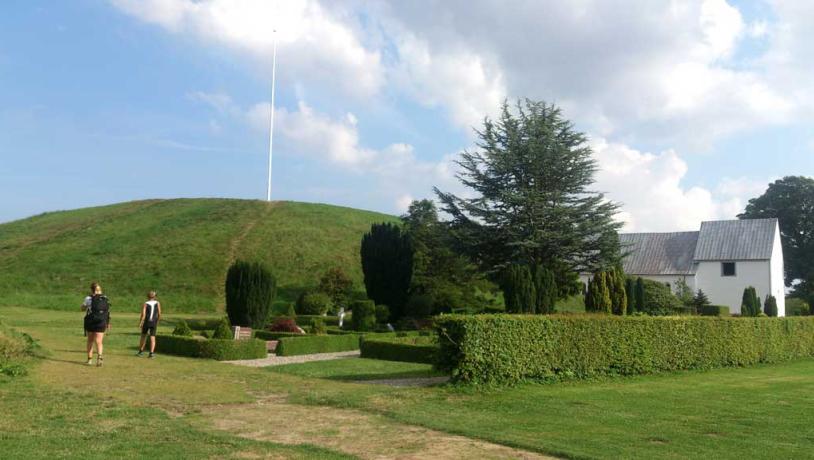
Travel report from the Ancient Road: An extreme runner on a family trip
An extreme runner’s travel report from a family summer holiday along the Ancient Road, travelling from Viborg in Denmark to Wedel 20 km west of Hamburg, Germany.
Background
I primarily see myself as a marathon runner but naturally also run a number of other official disciplines. These races mean you are running against the clock and this also applies to some of the training prior to these events. In recent years, I have nurtured a growing desire to forget the timekeeping and simply enjoy the freedom and nature. The trip down the Ancient Road in Denmark and its continuation, the Ochsenweg in Germany, was an inspiring experience based on minimal planning, minimum rules, minimal baggage, maximum nature and maximum freedom.
During the detailed planning, my two kids watched over my shoulder several times. I asked them if they wanted to go along with me, but knew in my heart that when push came to shove, it probably wasn’t so appealing to them. However, it turned out that they did want to join, which suddenly made it a somewhat different trip. Now my 17-year-old daughter Cirkeline and my 13-year-old son Mikkel were a part of a team that would bike along on the trip with me, while I would be running, of course.
We started on 27 July 2014 from Viborg Station at 8:00 expecting to reach Wedel, 20 km west of Hamburg, somewhere between 7 to 10 days later – a trip we expected to be 540 kilometres (340 miles), but which turned out to be 538 kilometres. Our intention was that a follow car would set out supplies for us, and we planned that everyone was to carry their own baggage. We had sought information about the hiking and cycling routes along the Ancient Road from the tourist office in Viborg. The hiking route was an easy choice since it also accommodated the two of us travelling by bike. So that’s what we did.
The hiking route
From the outset, leaving the town of Viborg, we discovered a very well signposted route. A few signs were a little tucked away and a couple were missing but in general they were spaced very close to each other so whenever you experienced longer periods without signage, you knew that something might be wrong. But as mentioned, there were only a couple of places like that which caused us no significant detours.
From the start we bought the Ancient Road book, which gave us most of the historical information about the route. It is quite thorough, factual and has good stories. The book comes with a map of the Ancient Road, which we also used to navigate by.
However, the super tool for wayfinding was the Ancient Road app. Once downloaded to your phone, you could zoom in to exactly where you stood, and the map showed the route in relation to your location. It was extremely detailed in the sense that you could see if the route ran on one side or the other of a row of trees. Amazing! And just one extra thing… your location was marked with a dot when you stood still but when you moved forward it changed to an arrow, which allowed you to see if you were moving in the right direction in relation to the route. You just needed to move 5 to 10 meters, before you got the whole picture. Ingenious!
As for the road surfacing, we had been told that you could travel along the Ancient Road hiking trails even on a racing bike, i.e. a bicycle with narrow wheels. The trail was really nice, but you cannot in any way use a racing bike. You need to use a more powerful bike with wide tires. My children travelled on mountain bikes, which was fine. In the woods you sometimes came across protruding roots and a few places there were also loose surfaces, which was demanding for the bikes, but the route was accessible. The roads alternated between forest trails, dirt or gravel lanes, former railway tracks-turned-footpaths and tarmac roads.

Photo:Henning Bechman
Accommodation along the Ancient Road
There were a number of shelters along the route. At most places there was running water and also a toilet. The sites were really nice and well maintained; really places you wanted to spend the night. Many places had tables and benches, and at other places there were small shelters with tables and benches, all very nice and well kept.
Nonetheless, there were hostels for every 20 km along the Ancient Road. Awesome! A small booklet is available with addresses and phone numbers and a small photo of each location. The booklet is also available on the Internet as a PDF file. We spent two nights at hostels, one in Jelling and one in Immervad. Both places with dormitory bunk beds, bathroom facilities and kitchen where you could cook your own food. In Immervad you could also buy food from the freezer. There was a stove and an oven for cooking. Really nice! Both places were in good condition and clean, which made you want to stay there.
Along the way we came across some wayside stalls where locals would sell groceries at reasonable prices. Some sold different kinds of snacks and water bottles; others sold candy, sodas and even blister plasters. There was a note with the prices, and you simply dropped the cash in the moneybox in the stall. Nice gesture!
We were surprised how few towns you passed if you stuck to the route. However, this places some demands on provisioning, especially when you travel very lightly. But you could reach a few more towns if you veered off route.
Experiences out of the ordinary
There were many attractions along our route but we had to skip some. We were, of course, guided by the aim of reaching our destination in time. But we enjoyed the experiences close by and spent time there. But if an attraction required a detour we would skip it. Among our experiences were ones of history, but also ones of nature, such as:
Eating wild fruit, such as raspberries, apples, plums, pears
Cooling down in the summer heat under the farmer's irrigation hose
Exploring high maize fields (with respect for the crops, of course)
Taking a break at the lookout tower at the fringe of a forest to gaze across the heather-clad heath
Having a hay fight on a newly harvested field
Having a potato war with already dug-up potatoes that were loose and useless on the field
Climbing bales of hay together and making them roll
Jelling Monumenterne
Other nature experiences included...
The fabulous Hald Lake and the hills of Dollerup Bakker
The disused train station in Bindeballe, which features vintage trains and wagons
The cosy merchant’s store, Bindeballe Købmandsgård
The historic Jelling Church, the Jelling Monuments, including Denmark's birth certificate, the Jelling Stones, which were impressive.
The former border to Germany, Kongeåen, which gave food for thought
The architecturally magnificent Immervad Bridge, Povls Bridge and the bridge of Gejåbro
The story of the Freedom Bridge
The border checkpoint in Bov, marked with a barrier, which apart from being a demarcation of the border between Denmark and Germany also represented the shift from the Ancient Road in Denmark and the German Ochsenweg.
The continued trip – the Ochsenweg
When planning the trip, we quickly noticed that the Ancient Road is a bigger attraction in Denmark than the continuation of the trail, called Ochsenweg, is in Germany. Rather than consisting of separate hiking and cycling routes, the German section is simply one long cycling route, according to the tourist office in Viborg. However, we did see signs marked with footprints and ‘Pilgrimage Route’, which suggested a hiking trail. Nevertheless, these often followed the cycling route, but not always.
Since the German route is more of a cycling experience, the trails were mainly tarmac country lanes. The route also wound through beautiful forests and other nature, but gradually the magnificent natural setting that had characterised the Ancient Road in Denmark gave way. Our penultimate stage, 120 km to 60 km from the target town of Wedel, consisted of long stretches of straight tarmac cycling paths that were decidedly dull compared to the Ancient Road. However, the Ochsenweg brought us through several cities, some larger cities like Flensburg, Rendsburg and Neumunster, as well as several smaller communities. This meant more options for provisioning and more people.
In Germany there are no hostels. We had to contend with hotels and campsites, and slept one night at a private home, simply by ringing the doorbell.
What did we get from the trip?
We had a great trip with many different experiences and good company – far away from PlayStation and Facebook. We spent quality time together in touch with nature. You get to appreciate having good company and getting a bed to sleep in, taking a bath and enjoying meals far more than you ever would in the safety and convenience of your home.
For us there was also a sporting angle, which was all about making an effort and achieving a goal. The thrill of reaching our goal in Wedel was immense. It was a feeling of elation, success and the completion of days of travel – from 7:30 am to 18:00 in the evening, some days even later – exposed to the sun and carrying a minimum of baggage, simply only what we were wearing. We all supported each other and we could all experience the sense of achievement. No one gave up. We made it. We won! We won over ourselves!
Packing list – Henning
My backpack weighed 4 kg, which was what in my experience I could run effortlessly with. Everything was packed in transparent bags to keep things in order and to protect them from rain. They contained:
Long compression running tights, long-sleeved compression running shirt, which I switched to in the evening and sometimes slept in as nightwear
A light lined, windproof Newline running jacket where the sleeves could be zipped off so it could be worn as a vest or worn with sleeves on chilly nights and mornings or when it was windy.
500-gram sleeping bag.
Foldable toothbrush, mini tube of toothpaste and pocketknife for different purposes.
Debit/credit card and mobile phone with charger and a small tubular emergency power unit in the event that a little power was needed at the end of the day.
Small reusable drinking bottles with 200 ml of water.
Small, light and cheap rain poncho.
After visits to the grocery store, it could also contain a little food.
Packing list – children
The kids had roughly the same in their backpack. They didn’t have to carry their own kit on their back so they had chosen to bring a few extra things. In addition, one carried a bike kit consisting of:
Repair kit with glue, patches and valve rubber.
Pliers to hold the patch until the glue has dried.
Adjustable wrench.
Allen key to adjust the bike.
They both rode mountain bikes with somewhat sturdy tires so we had no punctures.